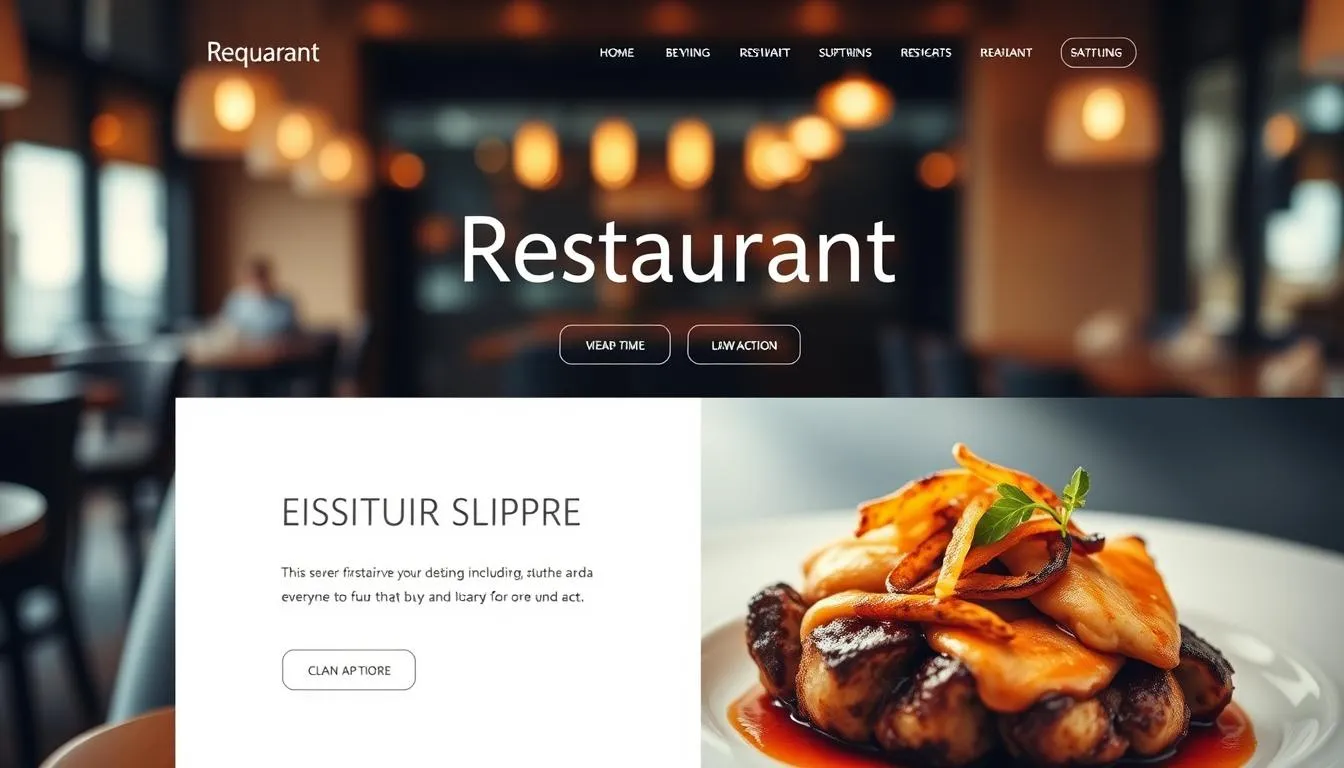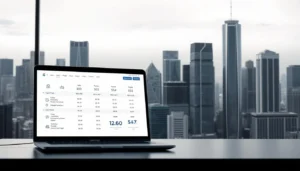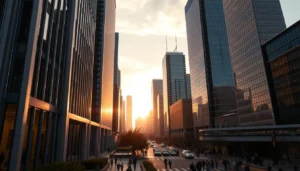Last Updated on: June 19, 2025
In today’s digital age, having a professional restaurant website design is crucial for attracting customers and enhancing their dining experience. A well-designed website not only showcases your restaurant’s ambiance and menu but also provides an easy way for customers to make reservations or order online.
A visually appealing and user-friendly website is essential for making a great first impression. With the help of web design services for restaurants, you can create an online presence that reflects your brand’s identity and values.
By investing in a professional website, you can increase customer engagement, drive sales, and stay ahead of the competition.
Key Takeaways
- A professional website is crucial for restaurants to attract customers.
- Web design services can help create a visually appealing and user-friendly website.
- A well-designed website enhances the dining experience and drives sales.
- It provides an easy way for customers to make reservations or order online.
- A professional online presence reflects your brand’s identity and values.
The Digital Storefront: Why Your Restaurant Needs a Professional Website
A well-designed website serves as a digital storefront, welcoming potential customers into your restaurant. In today’s competitive dining landscape, having a professional online presence is crucial for attracting and retaining customers.
The Impact of Online Presence on Restaurant Success
A robust online presence can significantly impact a restaurant’s success by increasing visibility, driving traffic, and enhancing customer engagement. A professional website is often the first point of contact between a potential customer and your restaurant, making it a critical component of your overall marketing strategy.
Key Statistics on How Websites Drive Restaurant Traffic
Recent studies have shown that a well-designed website can drive significant traffic to restaurants. For instance, a survey found that nearly 80% of diners search online for restaurants before visiting. Here’s a snapshot of key statistics:
As noted by a restaurant industry expert, “A website is not just a digital brochure; it’s a powerful marketing tool that can drive sales and customer loyalty.”
Essential Elements Every Successful Restaurant Website Must Include
For restaurants, having a website that incorporates essential elements is no longer a luxury, but a necessity. A well-crafted website serves as a digital storefront, providing potential customers with their first impression of your establishment.
Mobile-Friendly Design and Responsive Layouts
A mobile-friendly design is crucial, as most diners use their smartphones to search for restaurants. A responsive layout ensures that your website looks great and functions smoothly across various devices, enhancing user experience.
High-Quality Food Photography
High-quality food photography is another essential element, as it showcases your dishes in the most appealing way, enticing visitors to dine with you. Investing in professional food photography can significantly elevate your website’s visual appeal.
Online Menu with Updated Offerings
An online menu that is regularly updated is vital for keeping your website fresh and relevant. It allows customers to browse your offerings and makes it easier for them to decide to visit.
Clear Call-to-Action Elements
Clear call-to-action elements, such as “Make a Reservation” or “Order Online,” guide visitors through your website, encouraging them to take the desired actions. This enhances customer engagement and drives sales.
How to Create a Restaurant Website with Web Design Services?
Crafting a restaurant website that attracts diners involves more than just aesthetics; it demands a strategic approach with web design experts. To create an effective online presence, you need to consider several key factors, from finding the right web design partner to understanding the collaborative process involved.
Finding the Right Web Design Partner for Your Restaurant
When searching for a web design partner, look for experience in restaurant websites. Review their portfolio for designs that resonate with your brand’s style and cuisine. Ensure they understand your vision and can translate it into a functional, visually appealing website. Check for client testimonials and case studies to gauge their success in the industry.
In-House vs. Agency: Weighing Your Options
Deciding between hiring an in-house team or partnering with a web design agency depends on your resources and needs. An in-house team offers more control, while an agency brings diverse expertise and experience. Consider the pros and cons of each option based on your restaurant’s specific requirements and budget.
Budget Considerations and ROI Expectations
Establishing a budget for your restaurant website is crucial. Consider not just the initial design costs but also ongoing maintenance and update expenses. Expect a well-designed website to provide a significant return on investment through increased customer engagement and reservations. Here’s a simplified breakdown of potential costs and ROI:
The Collaborative Process with Design Experts
The process of creating your restaurant website involves close collaboration with web design experts. From initial consultations to launch, clear communication of your brand identity and goals is essential. Work closely with your designers to ensure your vision is accurately represented online.
Planning Your Restaurant Website: A Strategic Approach
Creating a restaurant website requires a strategic approach to effectively showcase your brand and offerings. A well-planned website is crucial for attracting and retaining customers in today’s digital age.
Defining Your Restaurant’s Unique Brand Identity
Your restaurant’s brand identity is what sets you apart from the competition. It’s essential to define your brand’s personality, values, and aesthetic to create a consistent online presence. As Simon Sinek once said, “The goal is not to do better than the other person, it’s to be better than you used to be.” Identify your unique selling proposition and let it shine through your website.
Setting Clear Goals for Your Website
Setting clear goals for your website is vital to measure its success. Determine what you want to achieve with your website, whether it’s increasing online orders, driving phone calls, or boosting reservations. Having specific goals will help you create a focused content strategy.
Creating a Content Strategy That Engages Diners
A content strategy that resonates with your target audience is crucial for engaging diners. Develop a content plan that includes menu updates, behind-the-scenes stories, and promotions to keep your audience interested.
Timeline Development with Your Design Team
Collaborating with your design team to develop a timeline ensures that your website launch is smooth and timely. Establish milestones and deadlines to keep the project on track.
“A great website is not just about aesthetics; it’s about creating an experience that drives results.”
— Restaurant Marketing Expert
Design Elements That Capture Your Restaurant’s Atmosphere
To effectively capture your restaurant’s unique atmosphere online, you need to focus on key design elements that reflect your brand and cuisine. A well-crafted website is essential for making a great first impression on potential customers.
Color Schemes and Typography That Reflect Your Cuisine
The color scheme and typography of your restaurant website are crucial in setting the tone for your brand. For instance, a seafood restaurant might opt for calming blues and whites, while an Italian trattoria might choose warm, earthy tones. Typography should be legible and consistent with your brand identity. Consider how different fonts can evoke different emotions and cuisines.
Layout Considerations for Different Restaurant Types
The layout of your website should be tailored to your restaurant type. For example, a fine dining establishment might require a more elegant and minimalist design, while a casual diner might benefit from a more vibrant and playful layout. Consider the user experience and how visitors will navigate your site.
Visual Storytelling Through Design
Visual storytelling is a powerful tool for restaurants. High-quality images of your dishes, kitchen, and dining area can help tell the story of your restaurant. Use design elements to create a narrative that engages visitors and makes them want to dine with you.
Working with Designers to Translate Your Vision
Collaborating with experienced web designers is key to bringing your restaurant’s vision to life online. They can help you choose the right design elements, from color schemes to typography, to create a website that accurately represents your brand.
Must-Have Features for Modern Restaurant Websites
Modern restaurant websites require a combination of appealing design and functional features to succeed. In today’s competitive dining landscape, a restaurant’s website is often the first point of contact with potential customers, making it crucial for driving sales and customer engagement.
Online Reservation Systems and Integration
One of the most critical features for modern restaurant websites is an online reservation system. This allows customers to book tables easily, reducing the workload on restaurant staff and minimizing the risk of no-shows. Integration with popular reservation platforms like OpenTable can streamline this process.
Online Ordering Capabilities
With the rise of food delivery and takeout, online ordering capabilities have become essential. Restaurants can integrate their website with online ordering systems, allowing customers to place orders directly. This not only enhances customer convenience but also increases revenue potential.
Location and Hours with Interactive Maps
Clear display of location and hours is vital for customer convenience. Incorporating interactive maps, such as Google Maps, can help customers find the restaurant easily and get directions. This feature is particularly important for restaurants with multiple locations.
Customer Reviews and Testimonials
Customer reviews and testimonials play a significant role in building trust and attracting new customers. Restaurants can showcase positive reviews on their website, providing social proof and enhancing their reputation.
Event Calendars and Special Promotions
Event calendars and special promotions can help drive customer engagement and increase sales. By highlighting upcoming events, such as live music nights or holiday specials, restaurants can attract more customers and create a buzz around their brand.
By incorporating these must-have features, modern restaurant websites can provide a seamless and engaging experience for customers, ultimately driving business success.
Content Creation Strategies for Restaurant Websites
Crafting a compelling narrative is key to engaging diners and driving sales. Effective content creation is crucial for a restaurant’s online presence, setting the tone for the dining experience and building a loyal customer base.
Crafting Compelling About Us and Chef Stories
The “About Us” section is more than just a page on your website; it’s an opportunity to share your restaurant’s story, values, and mission. Highlighting your chef’s journey and the inspiration behind your cuisine can create a personal connection with your customers. Use this section to showcase the people behind the restaurant and the passion that drives your culinary creations.
Menu Descriptions That Sell
Menu descriptions play a crucial role in enticing customers to try your dishes. Use vivid language to describe the flavors, ingredients, and preparation methods. This not only helps customers make informed decisions but also builds anticipation for the meal. Consider including stories behind signature dishes or the sourcing of ingredients to add depth.
Blog and Recipe Content to Boost Engagement
Blogging and sharing recipes can significantly boost engagement on your website. By sharing cooking tips, behind-the-scenes stories, and customer experiences, you can create a community around your restaurant. Regularly updated content also improves your website’s SEO, making it more visible to potential customers.
Professional Copywriting vs. DIY Content
While DIY content can be cost-effective, professional copywriting brings expertise and creativity to your content. Professionals can craft compelling narratives that resonate with your target audience, potentially leading to increased customer engagement and loyalty. Weigh the benefits of professional copywriting against the DIY approach to decide what’s best for your restaurant’s online presence.
Technical Considerations for Restaurant Website Development
Building a restaurant website that converts visitors into customers requires attention to technical details. A well-developed website is crucial for providing a seamless user experience, ensuring that diners can easily navigate and interact with your site.
Choosing the Right Platform
Selecting the appropriate platform for your restaurant website is a critical decision. Options like WordPress, Squarespace, and custom solutions each have their pros and cons. WordPress offers flexibility and a wide range of plugins, while Squarespace provides a sleek, user-friendly interface. Custom solutions offer tailored functionality but can be more expensive.
Speed Optimization for Hungry Visitors
Visitors to your restaurant website are likely to be hungry and impatient. Ensuring your site loads quickly is crucial. Techniques for speed optimization include compressing images, leveraging browser caching, and minimizing HTTP requests.
Security Measures for Online Transactions
If your website processes online payments, robust security measures are essential. Implementing HTTPS, using secure payment gateways, and regularly updating your software can protect customer data and build trust.
Menu Management Systems and Updates
An efficient menu management system allows you to update your offerings quickly. This can be particularly important for seasonal menus or daily specials. Look for a platform that supports easy menu updates without requiring extensive technical knowledge.
Third-Party Integration Capabilities
The ability to integrate third-party services can enhance your website’s functionality. This might include online reservation systems, delivery services, or social media feeds. Ensure your platform can support these integrations to provide a richer user experience.
SEO Strategies to Help Diners Find Your Restaurant Online
With most consumers turning to online searches to find dining options, restaurants must optimize their websites for search engines. Effective SEO strategies can significantly improve a restaurant’s online visibility, driving more customers through their doors.
Local SEO Tactics for Restaurants
Local SEO is crucial for restaurants as it helps them appear in search results for location-based queries. This involves optimizing the website with location-specific keywords, creating content relevant to the local community, and ensuring the restaurant’s listing is accurate and consistent across the web.
Keyword Research for Culinary Businesses
Keyword research is the foundation of any successful SEO strategy. For restaurants, this means identifying relevant terms and phrases that potential customers use when searching for dining options. Tools like Google Keyword Planner can help identify high-traffic keywords.
Google My Business Optimization
Claiming and optimizing a Google My Business listing is essential for local SEO. This includes providing accurate and up-to-date information, responding to customer reviews, and adding high-quality photos.
How Web Design Experts Can Enhance Your SEO
Web design experts play a crucial role in enhancing a restaurant’s SEO. They can ensure the website is mobile-friendly, has fast loading speeds, and is structured in a way that search engines can easily crawl.
Integrating Social Media with Your Restaurant Website
In today’s digital landscape, integrating social media with your restaurant website is no longer a luxury, but a necessity. This integration can significantly enhance your online presence, improve customer engagement, and drive sales.
Social Feeds and Sharing Capabilities
One of the key aspects of social media integration is incorporating social feeds into your website. This allows visitors to see your latest social media posts directly on your site, encouraging engagement and keeping your content fresh. Moreover, implementing sharing capabilities makes it easy for customers to share your content on their own social media platforms, expanding your reach.
Instagram-Worthy Content Strategies
Creating content that is Instagram-worthy is crucial for restaurants. This involves not just high-quality food photography but also storytelling through your dishes and the dining experience. Strategies include using vibrant colors, unique presentation, and behind-the-scenes content to captivate your audience.
Building Community Through Social Integration
Social media integration helps in building a community around your restaurant. By engaging with your followers, responding to comments, and creating interactive content, you can foster a loyal customer base. This community can become a powerful advocate for your brand, promoting your restaurant through word-of-mouth and online reviews.
Coordinating Social Media and Website Design
It’s essential to coordinate your social media presence with your website design to create a cohesive brand image. This includes using consistent branding elements such as logos, color schemes, and typography across both your website and social media platforms. A unified brand presence reinforces your identity and makes your brand more recognizable.
Maintaining and Updating Your Restaurant Website
The key to a successful restaurant website lies in its maintenance and timely updates. Regular maintenance ensures that your website remains relevant, secure, and continues to attract customers.
Regular Menu and Content Updates
Keeping your menu and content up-to-date is crucial. It reflects the current offerings of your restaurant and keeps customers informed. Regular updates also improve your website’s visibility on search engines.
Seasonal Design Refreshes
Updating your website’s design seasonally can keep it looking fresh and engaging. It allows you to promote seasonal menus and create a timely atmosphere that resonates with your customers.
Ongoing Support from Web Design Experts
Having ongoing support from web design experts can help you address any issues promptly and keep your website running smoothly. They can also provide valuable insights on how to improve your website.
Training Staff to Manage Website Content
Training your staff to manage website content can empower them to make necessary updates, reducing reliance on external resources.
Conclusion: Serving Up Digital Excellence for Your Restaurant
A well-designed restaurant website is crucial for achieving digital excellence and driving restaurant website success. By incorporating essential elements, such as mobile-friendly design, high-quality food photography, and online reservation systems, restaurants can create a compelling online presence that attracts and retains customers.
To achieve digital excellence, restaurants must also prioritize ongoing maintenance and updates, ensuring their website remains fresh and relevant. This includes regular menu updates, seasonal design refreshes, and ongoing support from web design experts.
By following the strategies outlined in this article, restaurants can create a website that not only showcases their brand but also drives business results. With a strong online presence, restaurants can increase customer engagement, drive sales, and ultimately achieve restaurant website success.
FAQ
What are the essential elements of a successful restaurant website?
A successful restaurant website must include a mobile-friendly design, high-quality food photography, an updated online menu, and clear call-to-action elements to drive customer engagement.
How do I create a restaurant website with web design services?
To create a restaurant website, you can find the right web design partner, weigh the pros and cons of in-house vs. agency design, consider your budget and ROI expectations, and collaborate with design experts to bring your vision to life.
What are the must-have features for modern restaurant websites?
Modern restaurant websites should include online reservation systems, online ordering capabilities, location and hours with interactive maps, customer reviews and testimonials, and event calendars and special promotions to enhance the user experience.
How can I improve my restaurant's online presence with SEO strategies?
You can improve your restaurant’s online presence by implementing local SEO tactics, conducting keyword research, optimizing your Google My Business listing, and working with web design experts to enhance your SEO.
How often should I update my restaurant website?
You should regularly update your menu and content, consider seasonal design refreshes, and receive ongoing support from web design experts to ensure your website remains relevant and effective.
What are the benefits of integrating social media with my restaurant website?
Integrating social media with your restaurant website can help you build a community, increase engagement, and drive sales through social feeds and sharing capabilities, Instagram-worthy content strategies, and coordinated social media and website design.
How can I ensure my restaurant website is secure?
To ensure your restaurant website is secure, you should implement security measures for online transactions, choose a secure platform, and keep your website software up-to-date to protect against cyber threats.
What is the importance of having a content strategy for my restaurant website?
A content strategy can help you craft compelling stories, write effective menu descriptions, and boost engagement through blog and recipe content, ultimately driving sales and customer loyalty.




